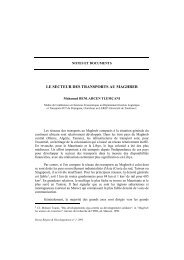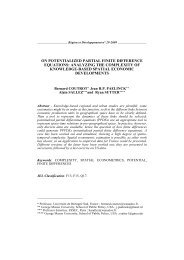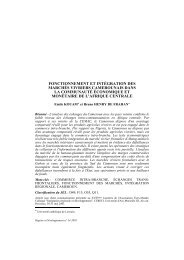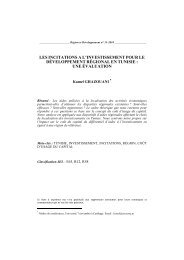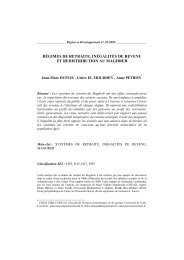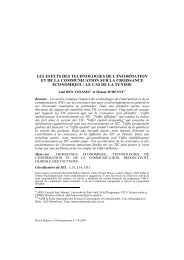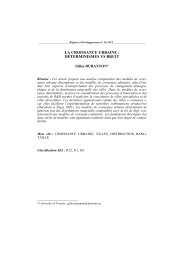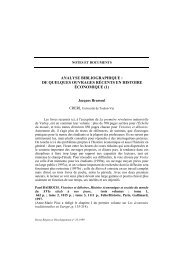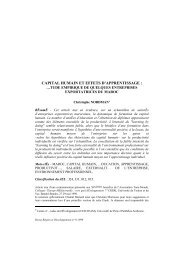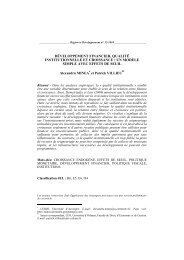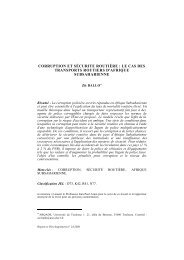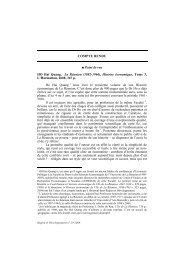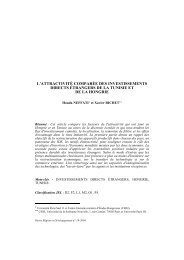space and growth: a survey of empirical evidence ... - ResearchGate
space and growth: a survey of empirical evidence ... - ResearchGate
space and growth: a survey of empirical evidence ... - ResearchGate
You also want an ePaper? Increase the reach of your titles
YUMPU automatically turns print PDFs into web optimized ePapers that Google loves.
26 Maria Abreu, Henri L.F. de Groot <strong>and</strong> Raymond J.G.M. Floraxa spatial dimension. For example, we have seen that institutions <strong>and</strong> technologycan be a function <strong>of</strong> climate <strong>and</strong> geography. Third, we have seen that other types<strong>of</strong> spillovers tend to have a localized effect, contributing to convergence amongcountries or regions located close to each other.The concept <strong>of</strong> club convergence is related to that <strong>of</strong> spatial heterogeneity,<strong>and</strong> several studies use spatial regimes to model it. One example is Dall'erba <strong>and</strong>Le Gallo (2004) who study club convergence among regions in the core <strong>and</strong>periphery <strong>of</strong> the European Union. They find convergence among the regions <strong>of</strong>the periphery but not among the regions <strong>of</strong> the core. Ramajo et al. (2003)consider the possibility that regions in the EU cohesion-fund countries (Irel<strong>and</strong>,Greece, Portugal <strong>and</strong> Spain) are converging separately from the rest <strong>of</strong> theEuropean Union. The results show that convergence is faster among the cohesionregions. Other methods used in spatial econometrics to study club convergenceinclude stochastic kernels (Carrington, 2003b), Markov chain modeling (Rey,2001), <strong>and</strong> Bayesian spatial econometrics (Ertur et al., 2003)4.We now come to the 62% <strong>of</strong> spatial econometric studies <strong>of</strong> <strong>growth</strong> thatfocus mainly on methodological issues. In general, these studies follow ast<strong>and</strong>ard procedure whereby the data is first tested for spatial autocorrelation,<strong>and</strong> the results are presented visually on a map or a Moran scatterplot. Localstatistics <strong>of</strong> spatial autocorrelation can also be computed; they indicate thedegree <strong>of</strong> spatial autocorrelation centered on a specific observation.A simple model is then estimated using Ordinary Least Squares, <strong>and</strong>spatial diagnostics are computed. These indicate whether there is spatialautocorrelation in the residuals. Lagrange Multiplier tests also indicate whether aspatial lag or a spatial error model <strong>of</strong> spatial dependence is the most appropriate(following the decision rule suggested by Anselin <strong>and</strong> Florax, 1995). In a spatiallag model the <strong>growth</strong> rate <strong>of</strong> per-capita income in one country depends on the<strong>growth</strong> rate <strong>of</strong> per-capita income in its neighbors. We discuss the implications <strong>of</strong>this model in more detail in Section 3. In a spatial error model the spatialdependence is restricted to the error term. While there is sometimes a discussionon the possible causes <strong>of</strong> the observed type <strong>of</strong> spatial dependence (e.g., commonshocks, climate, institutions), the <strong>empirical</strong> model is chosen on the basis <strong>of</strong>diagnostics tests carried out on the data, <strong>and</strong> not derived from a theory.A typical example <strong>of</strong> a st<strong>and</strong>ard spatial econometrics study (<strong>and</strong> one <strong>of</strong> thefirst to apply spatial econometrics to <strong>growth</strong>) is Rey <strong>and</strong> Montouri (1999). Inorder to detect spatial patterns in income <strong>and</strong> <strong>growth</strong> rates across the states <strong>of</strong> theUS, the authors first calculate global spatial autocorrelation statistics, <strong>and</strong> findthat incomes are correlated with those <strong>of</strong> neighboring states, <strong>and</strong> that the degree4 See Rey <strong>and</strong> Janikas (2005) for an in-depth review <strong>of</strong> these techniques <strong>and</strong> their use in spatialeconometrics.




